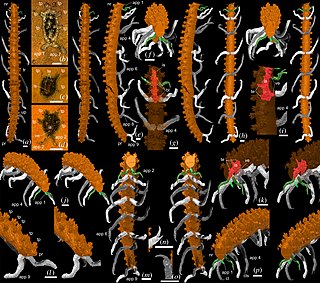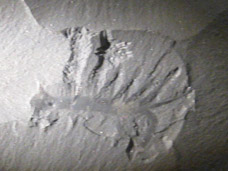
The lobopodians, members of the informal group Lobopodia, or the formally erected phylum Lobopoda Cavalier-Smith (1998), are panarthropods with stubby legs called lobopods, a term which may also be used as a common name of this group as well. While the definition of lobopodians may differ between literatures, it usually refers to a group of soft-bodied, worm-like fossil panarthropods such as Aysheaia and Hallucigenia.

Hallucigenia is a genus of Cambrian animal resembling worms, known from articulated fossils in Burgess Shale-type deposits in Canada and China, and from isolated spines around the world. The generic name reflects the type species' unusual appearance and eccentric history of study; when it was erected as a genus, H. sparsa was reconstructed as an enigmatic animal upside down and back to front. Hallucigenia was later recognized as a lobopodian, a grade of Paleozoic panarthropods from which the velvet worms, water bears, and arthropods arose.

Opabinia regalis is an extinct, stem group arthropod found in the Middle Cambrian Burgess Shale Lagerstätte of British Columbia. Opabinia was a soft-bodied animal, measuring up to 7 cm in body length, and its segmented trunk had flaps along the sides and a fan-shaped tail. The head shows unusual features: five eyes, a mouth under the head and facing backwards, and a clawed proboscis that probably passed food to the mouth. Opabinia probably lived on the seafloor, using the proboscis to seek out small, soft food. Fewer than twenty good specimens have been described; 3 specimens of Opabinia are known from the Greater Phyllopod bed, where they constitute less than 0.1% of the community.

Xenusion auerswaldae is an early lobopodian known from two specimens found in glacial erratics on the Baltic coast of Germany. They probably originated in the Kalmarsund Sandstone of Southern Sweden, which was deposited in the Lower Cambrian. It is the oldest currently known lobopodian with soft body fossils.

Microdictyon is an extinct armoured worm-like animal coated with net-like scleritic plates, known from the Early Cambrian Maotianshan shale of Yunnan China and other parts of the world. Microdictyon is part of the ill-defined taxon – Lobopodia – that includes several other odd worm-like animals that resembling worm with legs, such as Hallucigenia, Onychodictyon, Cardiodictyon, Luolishania, and Paucipodia. The isolated sclerites of Microdictyon are known from other Lower Cambrian deposits. Microdictyon sclerites appear to have moulted; one sclerite seems to have been preserved during ecdysis.

Panarthropoda is a proposed animal clade containing the extant phyla Arthropoda, Tardigrada and Onychophora. Panarthropods also include extinct marine legged worms known as lobopodians ("Lobopodia"), a paraphyletic group where the last common ancestor and basal members (stem-group) of each extant panarthropod phylum are thought to have risen. However the term "Lobopodia" is sometimes expanded to include tardigrades and onychophorans as well.

Pambdelurion is an extinct genus of panarthropod from the Cambrian aged Sirius Passet site in northern Greenland. Like the morphologically similar Kerygmachela from the same locality, Pambdelurion is thought to be closely related to arthropods, combining characteristics of "lobopodians" with those of primitive arthropods.

Facivermis is a genus of sessile lobopodian from the Lower Cambrian Maotianshan shales of China

Jianshanopodia decora is a Cambrian lobopodian. Its frontal, grasping appendages bear wedge-shaped plates. Its limbs branch, instead of being tipped with claws as many lobopods' are. It has a sediment-filled gut surrounded by serially repeated diverticulae. It is thought to have sucked up prey with its short 'trunk'. It mainly crawled on the sea floor, but could swim when necessary. Its mouth resembles those of anomalocaridids and priapulids.

Omnidens amplus, meaning "large all-tooth", is an extinct species of large Cambrian animal known only from a series of large mouth apparatus, originally mistaken as the mouthparts of anomalocaridids. When first named, it was interpreted as a giant priapulid, but is now considered a panarthropod. Its mouth apparatus closely resembles that of the smaller gilled lobopodian Pambdelurion, indicating it is likely to have been a close relative of that species, with which it may be synonymous. With a maximum estimated body length of 1.5 metres (4.9 ft), Omnidens is suggested to have been the largest known free-living Cambrian organism. Omnidens fossils are found in the Maotianshan Shales.

Diania is an extinct genus of lobopodian animal found in the Lower Cambrian Maotianshan shale of China, represented by a single species - D. cactiformis. Known during its investigation by the nickname "walking cactus", this organism belongs to a group known as the armoured lobopodians, and has a simple worm-like body with robust, spiny legs. Initially, the legs were thought to have a jointed exoskeleton and Diania was suggested to be evolutionarily close to early arthropods, but many later studies have rejected this interpretation.

The Luolishaniidae or Luolishaniida are a group of Cambrian and Ordovician lobopodians with anterior 5 or 6 pairs of setiferous lobopods. Most luolishaniids also have posterior lobopods each with a hooked claws, and thorn-shaped sclerites arranged as three or more per trunk segment. The type genus is based on Luolishania longicruris Hou and Chen, 1989, from the Chengjiang Lagerstatte, South China. They are presumed to have been benthic suspension or filter feeders.

Cardiodictyon is a genus of lobopodian known from 518 millions years old Chengjiang Lagerstätte. 525 millions years old partial fossil is also reported. It has ~25 pairs of legs, each associated with a pair of dorsal plates.
Quadratapora is a genus of lobopodian known only from its biomineralized dorsal plates, which somewhat resemble those of Microdictyon. Its fossils date to the Tommotian, representing the earliest record of lobopodians.

Megadictyon is a genus of Cambrian lobopodian with similarities to Jianshanopodia and Siberion. Occasionally mis-spelt Magadictyon.

Onychodictyon is a genus of extinct lobopodian known from the Lower Cambrian Chengjiang Maotianshan Shales in the Yunnan Province in China. It was characterized by a stout body covered by fleshy papillae and pairs of sclerotized plates with spines, representing part of the diverse "armoured lobopodians" alongside similar forms such as Microdictyon and Hallucigenia.
Luolishania is an extinct genus of lobopodian worm and known from the Lower Cambrian Chiungchussu Formation of the Chengjiang County, Yunnan Province, China. A monotypic genus, it contains one species Luolishania longicruris. It was discovered and described by Hou Xian-Guang and Chen Jun-Yuan in 1989. It is one of the superarmoured Cambrian lobopodians suspected to be either an intermediate form in the origin of velvet worms (Onychophora) or basal to at least Tardigrada and Arthropoda. It is the basis of the family name Luolishaniidae, which also include other related lobopods such as Acinocricus, Collinsium, Facivermis, and Ovatiovermis. Along with Microdictyon, it is the first lobopodian fossil discovered from China.

Thanahita is a genus of extinct lobopodian and known from the middle Silurian Herefordshire Lagerstätte at the England–Wales border in UK. It is monotypic and contains one species, Thanahita distos. Discovered in 2018, it is estimated to have lived around 430 million years ago and is the only known extinct lobopodian in Europe, and the first Silurian lobopodian known worldwide.

Hallucigeniidae is a family of extinct worms belonging to the group Lobopodia that originated during the Cambrian explosion. It is based on the species Hallucigenia sparsa, the fossil of which was discovered by Charles Doolittle Walcott in 1911 from the Burgess Shale of British Columbia. The name Hallucigenia was created by Simon Conway Morris in 1977, from which the family was erected after discoveries of other hallucigeniid worms from other parts of the world. Classification of these lobopods and their retatives are still controversial, and the family consists of at least four genera.

Lenisambulatrix is a genus of extinct worm belonging to the group Lobopodia and known from the Lower Cambrian Maotianshan shale of China. It is represented by a single species L. humboldti. The incomplete fossil was discovered and described by Qiang Ou and Georg Mayer in 2018. Due to its missing parts, its relationship with other lobopodians is not clear. It shares many structural features with another Cambrian lobopodian Diania cactiformis, a fossil of which was found alongside it.
















